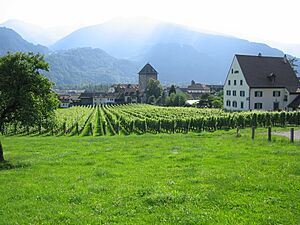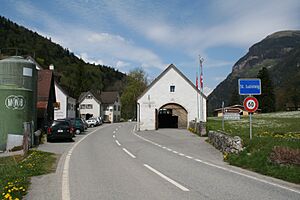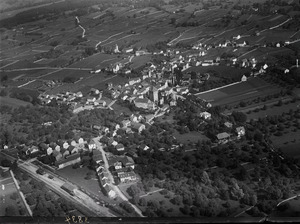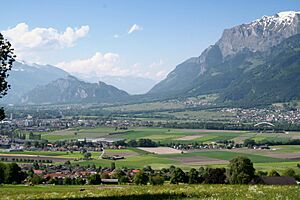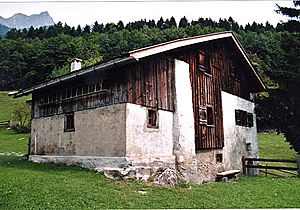Maienfeld facts for kids
Quick facts for kids
Maienfeld
|
||
|---|---|---|
 |
||
|
||
| Country | Switzerland | |
| Canton | Graubünden | |
| District | Landquart | |
| Area | ||
| • Total | 32.33 km2 (12.48 sq mi) | |
| Elevation | 635 m (2,083 ft) | |
| Highest elevation
(Hinter Grauspitz)
|
2,574 m (8,445 ft) | |
| Population
(Dec 2020 )
|
||
| • Total | 3,029 | |
| • Density | 93.690/km2 (242.66/sq mi) | |
| Postal code |
7304
|
|
| Surrounded by | Bad Ragaz (SG), Balzers (FL), Fläsch, Igis, Jenins, Malans, Mastrils, Nenzing (AT-8), Schaan (FL), Seewis im Prättigau, Triesen (FL), Zizers | |
Maienfeld (Romansh: Maiavilla) is a town in Switzerland, located in the Graubünden canton. It's a popular place for tourists because of its delicious local wine. It is also famous as the setting for the classic children's story Heidi.
| Top - 0-9 A B C D E F G H I J K L M N O P Q R S T U V W X Y Z |
Discovering Maienfeld's Past
Maienfeld is in a special spot in the Rhine Valley in the Alps. Long ago, people lived here, even in the Bronze Age! Romans also had a settlement here around 300 AD. Old maps from the 4th or 5th century show a place called Magia near where Maienfeld is today.
The village was first mentioned in the year 831. Back then, it was known as Lupinis. Over time, its name changed several times. Finally, in 1295, the name Maienvelt was used, which later became Maienfeld.
Castles and Walls: Protecting the Town
From the mid-900s to the mid-1100s, counts from Bregenz ruled Maienfeld. Their castle was destroyed in 1079. The castle you see today, Schloss Brandis, was first built around 1270. It was later rebuilt and made bigger in 1465.
The town also built strong walls in the 1200s to protect itself. A part of this old wall, about 4.5 meters (15 feet) tall and 1 meter (3 feet) thick, is still standing! The walls were made even taller and thicker in the 1300s.
Maienfeld's Rights and Changes
Maienfeld was first called a town in 1346. In 1388, it gained the right to charge a toll (a fee) on the old Roman Road. This road went from Chur over the St. Luzisteig pass to the north.
In the 1300s, a group of people called the Walser moved into the Maienfeld area. They started new settlements. At first, Maienfeld spoke a language called Romansh. But as more German-speaking Walser people moved in, the town became mostly German-speaking by the 1500s.
In 1458, a big fire damaged the town. Later, in 1499, during the Swabian War, Maienfeld had to let the Austrian army enter. After the Austrians left, the town was attacked and robbed by other troops.
In 1509, a group called the Three Leagues bought Maienfeld. This was a bit unusual because Maienfeld was also a voting member of one of these Leagues! This meant Maienfeld had a say in how it was managed.
In 1529, a new bridge was built over the Rhine River. This changed trade routes, and Maienfeld became less important for trade. The town was also badly damaged by fires again in 1622 and 1720.
Maienfeld was also home to a famous scholar named Hortensia von Moos (1659–1715). She was known for her writings about the role of women in society.
Exploring Maienfeld's Geography
Maienfeld is located about 8 kilometers (5 miles) southeast of Sargans. It sits in the lower Chur Rhine Valley. The town shares borders with several other communities and even with the country of Liechtenstein and Austria.
Maienfeld is on the right side of the Rhine valley. It includes smaller areas called Bovel, Rofels, and St. Luzisteig. St. Luzisteig is an important mountain pass that leads into Liechtenstein. It has an old fortress from the 1700s that is now used by the Swiss Army.
There were once old Walser settlements nearby. One, called Stürfis, was abandoned by 1633. Another, Guscha, was lived in until 1969. The last two families there were bought out by the Swiss Army, and the village became part of their training area.
Land Use and Natural Features
About 43% of Maienfeld's land is used for farming. This includes vineyards and fields. About 32% of the area is covered by forests. The rest of the land is used for buildings, roads, or is unproductive.
The train station in Maienfeld is 502 meters (1,647 feet) above sea level. The highest point in the town's area is the Hinterer Grauspitz mountain, which is 2,574 meters (8,445 feet) high.
People of Maienfeld
Maienfeld has a population of about 2,767 people (as of 2015). About 11% of the people living here are from other countries.
Most people in Maienfeld (about 92%) speak German. Portuguese is the second most common language, and Romansh is third.
In 2015, about 19.4% of the population were children and teenagers (0–19 years old). Adults (20–64 years old) made up 62% of the population, and seniors (over 64 years old) were 18.6%.
The chart below shows how Maienfeld's population has changed over time:

Tourism and Famous Stories
Maienfeld is most famous for being the setting of Heidi, a classic children's book by Johanna Spyri. Many people visit the area to see the places described in the story.
Important Historical Buildings
Two important buildings in Maienfeld are Brandis Castle and Salenegg Castle. These castles are listed as important Swiss heritage sites.
Education in Maienfeld
Many adults in Maienfeld (about 79%) have completed higher education. This means they have gone to a university or a specialized college after finishing high school.
Economy and Jobs
Maienfeld has a mixed economy. This means that both farming and service industries (like tourism, shops, and offices) are important for jobs.
In 2014, there were about 1,750 people working in Maienfeld.
- About 173 people worked in farming.
- About 499 people worked in manufacturing and construction.
- About 1,078 people worked in service jobs, like hotels, shops, and other businesses.
Maienfeld is also a popular place for tourists to stay. In 2015, hotels in Maienfeld had over 28,000 overnight stays. Almost half of these visitors were from other countries.
Religion in Maienfeld
Based on a census from 2000:
- About 29% of the people were Roman Catholic.
- About 58% belonged to the Swiss Reformed Church.
- Smaller numbers of people belonged to other Christian churches or were Islamic.
- About 5.5% of the population did not belong to any church.
Transportation
Maienfeld has a train station. It is located on the Chur–Rorschach railway line, which connects Sargans and Chur. Local trains stop at the Maienfeld railway station.
Famous People from Maienfeld
- Hortensia von Moos (1659–1715): A Swiss scholar known for her writings about women's roles.
- Theophil Sprecher von Bernegg (1850–1927): A Swiss politician and military leader.
- Heidi: The main character from the famous children's book, who came from Maienfeld.
- John Knittel (1891–1970): A Swiss writer who lived in Maienfeld.
- Fridolin Sulser (1926–2016): A Swiss-American scientist who studied mental disorders. He grew up in Maienfeld.
- Heinz Nigg (born 1949): A Swiss anthropologist and artist from Maienfeld.
See also
 In Spanish: Maienfeld para niños
In Spanish: Maienfeld para niños





